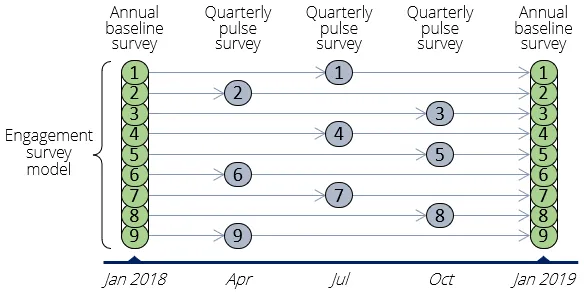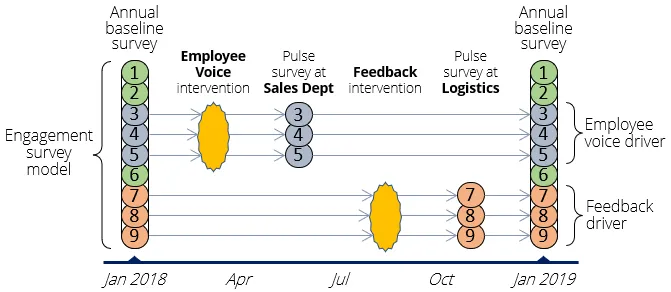To be effective, engagement surveys should not be based on a snapshot that measures how many employees feel engaged at any particular point in time; it should instead measure how often they felt engaged over a period of time.
Measuring the state of engagement over time
An effective way to measure engagement over time would be to compliment the annual baseline survey with a series of pulse or mini surveys that measure different aspects of engagement on a regular basis, say quarterly or even monthly. See Pulse Survey Questionnaires for more on how to do a pulse survey. In the illustration below, the 9 questions in the annual baseline survey are split into different groups and measured via pulse surveys every quarter. Varying the survey questions and restricting the pulse surveys to a maximum of 5 – 8 survey questions will help to prevent survey fatigue and ensure sufficient variety to keep the surveys interesting and fresh.

Measuring engagement on a more regular basis will provide you with a more accurate and up-to-date picture of the real state of engagement in your organization. It will also reinforce the notion that management is prepared to listen more often and is serious about improving engagement.
Tracking the impact of engagement interventions
Regular pulse surveys as outlined above will provide you with a more accurate picture of the fluctuations in engagement levels in the organization, but they won’t tell you how effective specific engagement interventions were at business unit level.
The best way to track and monitor the impact of individual interventions will be through pulse surveys that are targeted at specific business units and measure the outcomes of specific interventions. In the illustration below, targeted pulse surveys are used to measure the impact of an Employee Voice intervention in the Sales department and a Feedback intervention in the Logistics department.

Tracking the impact of engagement interventions on specific business units will empower managers at all levels of the organization to drive engagement in their teams. It will, in a sense, help to decentralize engagement: instead of HR being the sole custodians and drivers of engagement, HR will now focus on facilitating the process so managers at lower levels can effectively take ownership of engagement.
| For more information, click on a sub-menu item at the top of the page⇑ or in the right margin⇒ |
